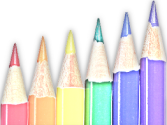"Investigating the Earth-Moon-Sun System"
"Investigating the Earth-Moon-Sun System"
Course(s)/Subject(s):
Grade Level(s):
Key Words:
Developer(s) Name:
School:
Attached files:
Approximate Time Frame: Materials/Equipment Needed:
In the 8 grade physical science unit, "Investigating the
Earth-Moon-Sun System", is the "It's Just a Phase" activity in which
students investigate the arrangement and
movement
- What is the objective of this lesson? The objective of this lesson is to have the students gain a broader understanding and appreciation for the process of scientific investigation, especially how observations and verbal or recorded data from ancient times have been the basis of our knowledge of the solar system.
VA
SOL(s)
- What will we examine as evidence of students' knowledge and/or skill?
- What exactly will the students and teacher do during the lesson?
- Students will first participate in the laboratory exercise, "It's Just a Phase".
- Discuss as a class the terms "rotation","revolution",
"seasons", "eclipse";the scientific
method of investigation; the instruments and technologyused by astronomers today to
gather information . - Discuss what ancient people might have thought about the
causes of natural eventssuch
as night and day. - Discuss the Internet as one source of Native American legends of the moon, sun and earth.
- Students will learn to access an Internet site. The class will
discuss site formats and the
value of using links at various sites. - Discuss the need to make hard copies of research material and to document sites carefully.
- Students will choose one of the web sites to use. See attached web site listings.
- Students will be instructed to create both written report on
ClarisWorks word processing
and an oral report on their story to present to the class.
- Teacher will instruct students about moon phases, seasons by
leading the "It's Just a
Phase" lab for one class period. - Teacher will lead a class discussion concerning moon phases, seasons, eclipses.
- The teacher will introduce the Internet as another source of information the students can
- Teacher will instruct students on how to access an Internet
site and discuss formats and
the value of links. - Teacher will discuss the importance of proper documentation of
Internet sites for research
purposes. - Teacher will direct students to choose one of the story web sites.
- Teacher will evaluate both a written report and an oral presentation by each student.
- Teacher will lead class discussions on information that is presented in the oral reports.
- What options in presentation(s) and/or response(s) are
suggested in order to provide the opportunity for all students to
demonstrate
achievement of the benchmark(s) and indicator(s)? - Discuss with teacher the information that was collected on the
Internet. Relate the legend to
one from the student's home country if they are a recent ESL student. - Students can make a poster to replace written assessment to
show information they found
concerning the comparison of the legend to the present day knowledge.
http://www.ac.wwu.edu/~skywise/legends.html#Walks
(Tsimshian:Sun, Moon, Stars)- http://www.ac.wwu.edu/~skywise/legends.html#Coyoteand
Eagle
(Zuni:Sun, Moon) - http://www.ac.wwu.edu/~skywise/legends.html#BoyandSun
(Hopi:Sun, Moon, Milky Way) - http://www.ac.wwu.edu/~skywise/legends.html#Sunand
her
(Cherokee:Sun, Moon) - http://www.ac.wwu.edu/~skywise/legends.html#Spiderand
Sun
(Cherokee:Sun, Milky Way) - http://www.ac.wwu.edu/~skywise/legends.html#LittleBro
(Winnebago:Sun) - http://www.ac.wwu.edu/~skywise/legends.html#FifthWorld
(Toltec:Sun, Earth)
- http://www.ac.wwu.edu/~skywise/legends.html#Foxand
Moon
(Snoqualmie:Moon) - http://www.ac.wwu.edu/~skywise/legends.html#Ravenand
Sun
(Tsimshian:Sun) - http://www.ac.wwu.edu/~skywise/legends.html#Coyote,
Wolves
(Wasco:Big Dipper) - http://www.ac.wwu.edu/~skywise/legends.html#EveningStar
(SkidiPawnee:Venus) - http: www.ac.wwu.edu/~skyswise/legends.html#LostChildren
(Blackfoot:Pleiades) - http://www.ac.wwu.edu/~skywise/legends.html#CoyoteMoon
(Kalispel:Moon) - http://www.ac.wwu.edu/~skywise/legends.html#Fisher
(Anishinabe:Big Dipper) - http// www.ac.wwu.edu/~skywise/legends.html#Threeleg
(Western Rocky:Sun, Moon, Stars) - http// www.indians.org/welker/howthegr.htm
(Moon, Sun) - http// www.indians.org/welker/mornings.htm
(Morning star) - http// www.indians.org/welker/origsumm.htm
(Summer, Winter) - http// www.indians.org/welker/northsta.htm
(North Star)

